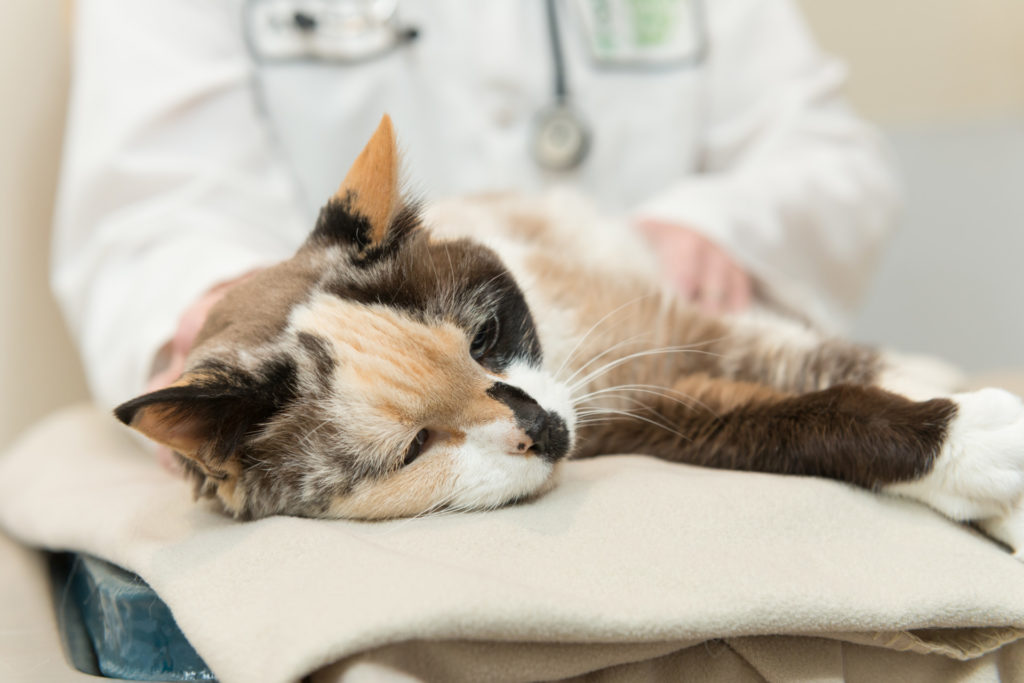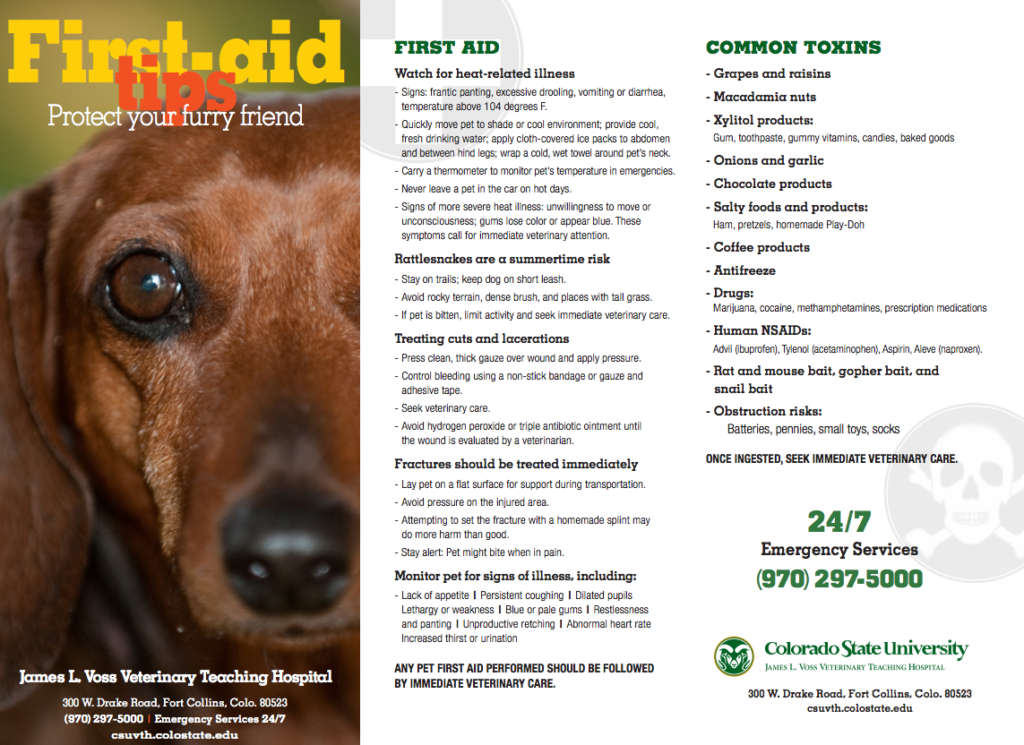
Above: Keep your pet healthy by understanding the risks of common household items that are toxic to dogs and cats. (Photo: John Eisele/CSU Photography)
By Dr. Sarah Smith
One of the best ways to avoid a medical emergency with your pet is to know about common household items that may be toxic when ingested by dogs and cats. This information will help you avoid potential dangers – and will help you respond if your pet does get into something poisonous.
When it comes to pet toxins, it’s important to understand that dogs and cats are not little people – meaning food and medicine that are fine for humans are sometimes poisonous to pets. That’s because our pets metabolize chemical compounds differently than we do, with different and sometimes dangerous effects.
When a pet comes to our Small Animal Emergency and Critical Care Unit after ingesting something toxic, we try to ascertain exactly what the animal ate, drank, breathed, or absorbed through its skin. This is critical in directing a treatment plan. It’s also the reason I urge pet owners to bring to the hospital any packaging from an item that might have been ingested: An ingredients list can be essential in helping a pet overcome toxicity.
Treatment for toxicity varies according to pet species, size, and the type and amount of toxin ingested. In many cases, we use one or more of the following strategies:
- induce vomiting;
- treat the animal with activated charcoal;
- provide antidotes if they are available;
- administer dialysis or blood products, as needed; and
- provide supportive care in the form of hospitalization, health monitoring, pain relief, and fluid replacement, among other treatments.
If you know your pet has ingested something dangerous – or if your animal is showing signs of illness with no apparent cause – be sure to seek veterinary care quickly. It’s useful to know that pets don’t always show immediate signs of acute illness, even when their organs are being damaged by a toxin.
There are a number of potential pet toxins common in our homes. Here are a several to know about.
People food – not pet food
- Chocolate: Most dangerous to pets are dark chocolate and products with high percentages of cacao, including cocoa beans, cocoa powder, bakers chocolate, and candy. Chocolate contains agents called methylxanthines that, even in low doses, may trigger symptoms in pets including vomiting, diarrhea, dehydration, irregular heartbeat, and even seizures. Milk chocolate is generally less dangerous to pets than dark chocolate with high percentages of cocoa listed on the wrapper. That said, it’s important to know that even milk chocolate can be lethal to pets. I advise immediately calling an emergency veterinary facility if you know your pet has consumed chocolate, as a vet can ask questions and calculate chocolate dose to determine best response.
- Grapes and raisins: Dogs are susceptible to kidney failure after eating grapes and raisins. We do not know the chemical agent that triggers problems in dogs, nor do we know the amount, or dose, that causes kidney failure. For this reason, veterinarians must consider any exposure toxic and treat accordingly. Signs of kidney failure include vomiting, lethargy, diarrhea, depression, and changes in drinking and urination.
- Xylitol: “Sugar-free” chewing gum, toothpaste, candy, baked goods, and peanut butter often contain the ingredient xylitol. This substitute sweetener is a sugar alcohol that may cause a severe drop in blood sugar and liver failure in dogs. The damage occurs when a dog’s body responds as if it received a blast of sugar: The pancreas releases insulin, followed by a drop in blood sugar that may lead that may lead to weakness, collapse, or seizures. Even some patients that do not develop signs of low blood sugar may develop liver failure later. Therefore, aggressive early treatment is recommended. If your dog gets into a pack of gum that contains xylitol, I recommend calling the ASPCA Animal Poison Control Center because the service maintains records of the amount of this sugar alcohol in different brands of chewing gum; that information is important in determining the dose a dog has received. In addition, take the dog to an emergency center so a veterinarian may induce vomiting, as needed.
- Unrisen bread dough: Raw bread dough contains active yeast cells that metabolize simple sugars found in flour. As the yeast does its work, it releases carbon dioxide and alcohol. This process makes bread dough rise – but it also makes dough toxic when ingested by dogs. Our dogs may literally become intoxicated by the alcohol in bread dough. In addition, as dough continues to rise in a dog’s stomach, the patient may experience a dangerous blockage. If the problem is caught early, it may be possible to halt the activity of yeast by feeding ice water and ice cubes, although more aggressive treatment, including abdominal surgery, is sometimes required.
Plant poisons

- Lilies: Flowering plants of the genus Hemerocallis and the genus Lilium (also known as “true lilies”) are very dangerous to cats, and every plant part has toxic effects, even with skin exposure. These flowering plants are known by common names including Daylily, Easter lily, Japanese lily, Stargazer lily and Tiger lily. Cats that ingest these plants typically vomit immediately, then begin suffering kidney injury; dehydration is often a serious secondary effect. Cats with this form of toxicity may often be successfully treated with aggressive fluid therapy – as long as we begin treatment within 18 hours of plant ingestion. In light of the danger posed to pet cats, I try to keep lilies out of my own home – and I suggest that when you give flowers to cat owners, make sure the bouquets are devoid of lilies.
- Marijuana: Pot is poisonous to pets because of the chemical compound tetrahydrocannabinol, known by the acronym THC. This is the psychoactive component of marijuana – the reason it produces a “high” in people. Dogs are far more sensitive to THC than are humans: The compound causes neurologic symptoms, including unsteadiness, heightened reactivity to touch and sound, urine loss, abnormal heartrate, breathing problems, and difficulty maintaining body temperature. These and related symptoms are signs of brain dysfunction. We most often see marijuana toxicity after dogs gobble up marijuana edibles, oils, or butter infused with THC. A pet may even suffer toxicity after ingesting small quantities of loose-leaf plant material or ashes. This is an important reason to keep pot and pot products safely stored.
Human medication
- Over-the-counter pain medication: Acetaminophen, aspirin, ibuprofen, and naproxen are examples of human pain relievers that are dangerous to dogs and cats. These drugs are the active ingredients in a wide variety of products with different brand names. We often see toxic effects after people have given their pets these drugs, mistakenly thinking that the meds will help a dog or cat just as they help a human. In fact, pets metabolize these drugs differently than we do – and therefore may suffer kidney failure, seizures, liver failure, or severe stomach ulcers after consumption. If you think your pet needs pain relief, call your veterinarian for guidance. This will ensure that any drug given is safe for your pet.
Other problematic household items
- Rat and mouse bait: Rodenticides, which are edible poisons designed to attract and kill rodents, are also toxic to pets. I urge cautious use of rodenticides in homes and properties where pets are present. In this category of toxin, it is especially important to have packaging on hand in case a pet emergency occurs. That’s because there are two types of rodenticides, and they require different treatment approaches. One form of rodenticide triggers internal bleeding; the other causes neurologic problems. Both can be lethal to pets. If caught quickly, internal bleeding can be prevented with a simple antidote. The neurologic form requires rapid decontamination and supportive care; unfortunately, there is no antidote.
- Antifreeze (ethylene glycol): This additive, which helps keep automotive engines running, is among the better-known pet toxins. Even so, it’s worth mentioning a couple key facts about the effects of antifreeze on pets. First, consumption of even a small amount of antifreeze can be deadly to dogs and cats. For instance, the lethal dose of antifreeze for a cat is about 1 teaspoon; that means a cat will become ill when ingesting even less. Second, pets need veterinary care very quickly after antifreeze ingestion to avoid kidney failure and death. In some cases, pets that have licked up antifreeze will vomit, appear unsteady, and show signs of thirst; then they may appear to recover. Meantime, the ethylene glycol in antifreeze is causing kidney damage that can be fatal. Bottom line: Time is of the essence when a pet has consumed antifreeze. An antidote can be administered, but only if treatment is started within the first few hours of ingestion. Our veterinary hospital is one of the few that provides dialysis, which filters a pet’s blood in an effort to avoid kidney damage; it can be the difference between life and death. To avoid problems, be sure to safely store antifreeze and to thoroughly clean up any product that spills or leaks.
Dr. Sarah Smith is a veterinarian with the Small Animal Emergency and Critical Care Unit at Colorado State University’s James L. Voss Veterinary Teaching Hospital.

Resources
- Keep contact information handy for veterinary emergency care. Our James L. Voss Veterinary Teaching Hospital is among those offering 24/7 emergency care. The hospital is at 300 W. Drake Road, Fort Collins. Telephone: (970) 297-5000.
- ASPCA Animal Poison Control Center provides information and help through its hotline, (888) 426-4435, and on its website, aspca.org/apcc.
- The Pet Poison Helpline also provides information and help through its hotline, (800) 213-6680, and on its website, petpoisonhelpline.come.